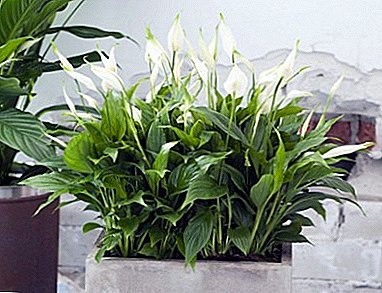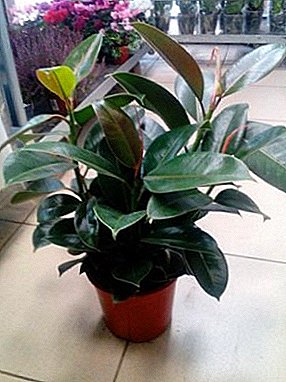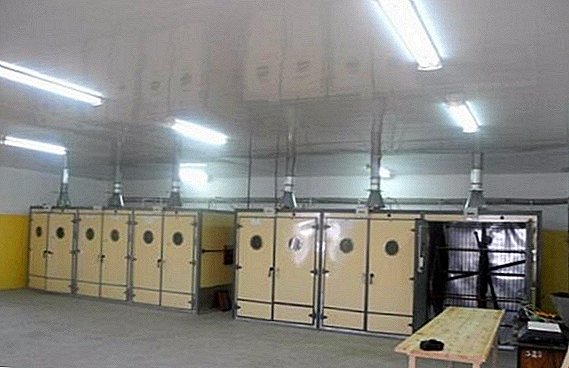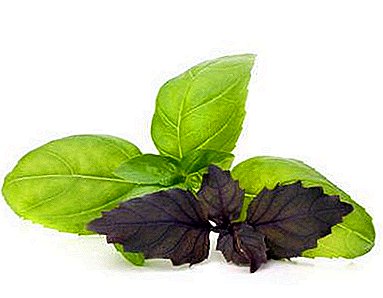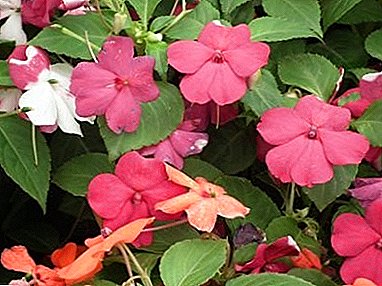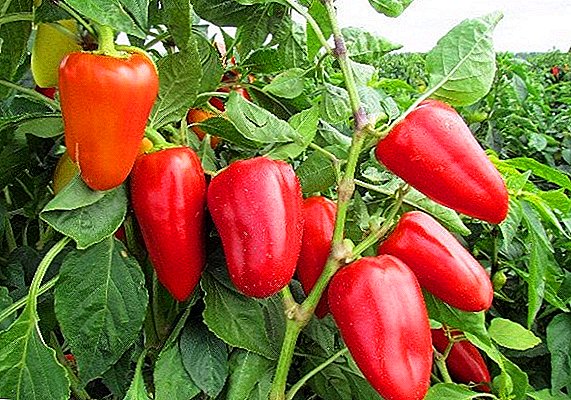 Pepper "Atlant" is rather easy to grow on your own plot, since this crop is resistant to diseases, does not need mandatory garter and certain growth conditions. How to grow peppers from seeds and seedlings - read below.
Pepper "Atlant" is rather easy to grow on your own plot, since this crop is resistant to diseases, does not need mandatory garter and certain growth conditions. How to grow peppers from seeds and seedlings - read below.
Description and characteristics of the variety
This variety is a hybrid and has a high yield. The shrub of the plant is small, low, refers to the semi-clade species. If you compare it with other varieties, this one is not very spreading and does not differ in a large number of leaves.  The description of “Atlant” pepper should be supplemented by the fact that it is an early ripe variety - from the time of young fruit emergence and it takes about 105-125 days to fully ripen. Fruits are cone-shaped and large in size with two or three chambers, distinguished by juiciness and fleshiness. Their color is rich red, the flesh is very tasty and sweet, and the mass of one fruit can reach 200 g.
The description of “Atlant” pepper should be supplemented by the fact that it is an early ripe variety - from the time of young fruit emergence and it takes about 105-125 days to fully ripen. Fruits are cone-shaped and large in size with two or three chambers, distinguished by juiciness and fleshiness. Their color is rich red, the flesh is very tasty and sweet, and the mass of one fruit can reach 200 g.
Familiarize yourself with the agrotechnics of growing other varieties of sweet peppers: "Gypsy F1", "Bogatyr", "California miracle", "Ox ear", "Anastasia", "Orange miracle".
The variety has a high yield and good resistance to various diseases. The description and characteristics of pepper "Atlant" varieties will not be complete, unless you indicate that the plants of this variety do not need special care or regular watering. It should also be noted that during transportation this variety does not lose its appetizing appearance and taste.
Landing
To get a big harvest of healthy and tasty fruits, you need to know exactly how to plant and grow these plants. Even despite the unpretentiousness of sweet pepper "Atlant", there are still some secrets in the cultivation of this variety. 
Seed preparation
Before planting, work with the seeds. Soak them in water and leave for a few hours before swelling. When the seeds swell, move them to a weakly concentrated solution of potassium permanganate.
Rinse the seeds in clean running water. Now 12 hours they should be in the water, which must be diluted with a growth stimulator. Rinse again after this.
Important! A solution of potassium permanganate, in which the seeds will be, does not need to be made very concentrated, as this can spoil them.
Sowing seeds
The best time for landing is the first half of February. Seeds are best placed immediately in cassettes. The soil can be prepared with his own hands or purchased from the store.  When buying a soil, choose a special one for growing vegetables. If you prepare it yourself, then you should mix the soil with sand, sawdust and humus, you should also add a small amount of ash.
When buying a soil, choose a special one for growing vegetables. If you prepare it yourself, then you should mix the soil with sand, sawdust and humus, you should also add a small amount of ash.
Learn about the best varieties of pepper for growing in Siberia and the Moscow region.
Carefully pour the soil into the prepared pots. The earth should not be compressed, because the seeds will germinate only in loose and soft earth. Immerse the seeds in the ground is not less than 1 centimeter.
Growing seedlings
For seedlings pick up containers with a diameter of at least 10 centimeters. These can be peat pots, which, when planted, can be buried in the soil without removing the seedlings from them. This will help keep the root system of plants intact and intact. Cover seedlings with material that will let the sun's rays through.  Since this variety is thermophilic, put the plants in a lighted and warm enough place. Strong drafts of seedlings are contraindicated. Check the soil every day so that it does not dry out. Ventilate the seedlings need several times a week. When the first sprouts appear, rearrange the seedlings on the windowsill, because this is a light-loving plant.
Since this variety is thermophilic, put the plants in a lighted and warm enough place. Strong drafts of seedlings are contraindicated. Check the soil every day so that it does not dry out. Ventilate the seedlings need several times a week. When the first sprouts appear, rearrange the seedlings on the windowsill, because this is a light-loving plant.
Important! Make sure that the seedlings are not frozen near the cold window. Acceptable temperature for seedlings - 24-28 degrees during the day and 21-25 at night.
Transfer
Seedlings of this sweet vegetable can be transplanted into open soil only after it has reached 40-50 days. A few weeks before landing, begin to harden the seedlings. You can take it to the street and leave it for a while. This procedure will allow young plants to quickly adapt to the open space in which they will grow, and to avoid stress, slowing the growth of seedlings.
During transplantation, consider the temperature indicators of air, prolonged cooling or freezing are detrimental to pepper. 
Important! Hardening the seedlings will also help them prepare for intense solar radiation, which can cause burns without preparation.
Care
The vegetation period of plants does not differ particularly care. In the description of care for pepper variety "Atlant F1" it is worth mentioning the regular fertilizing, watering and loosening the soil.
Watering
Water abundantly at least three times a week. Water should be no lower than room temperature or slightly warmer. Forget about watering with ice or hot water. This should not be done, the plants will grow worse. On hot days, you can water the seedlings even every day. 
Fertilizer
Feed the seedlings with fertilizer once every 20 days. Fertilizers can be organic or special, which contain complexes of potassium, nitrogen, phosphorus and other trace elements.
Plants can be fed with a solution with nitrogen, where 10 liters of water is diluted with quality manure. The main thing is that the mixture does not get to the roots, because it can burn the root system. Phosphorus-potassium fertilizers are well suited for feeding before the appearance of the fruit.
Processing shoots
Pepper "Atlant F1" does not need to handle shoots. But he needs a garter, because even with small sizes the bushes can grow well upwards. To provide good support for sprouts, tie tree branches or thin boards to plant stalks. Now the plant stems will not be broken by gusts of strong wind. 
Did you know? The largest Bulgarian pepper in the world was grown by Israeli farmers in the moshav Ein Yahav. The weight of one fruit was 0.5 kg.
Diseases and pests
This variety can be attacked by pests. The most common type of pepper pest is aphid. Most often, just one treatment is enough, using a solution of laundry soap. If there are too many pests, you can use any insecticide to control agricultural pests.
Another pepper lover is a spider mite that attacks plants in particularly arid and hot weather. To get rid of it, you need to apply one of the special acaricidal drugs.  A stable and dangerous pest for vegetable crops is the whitefly. For the destruction of this species are used insecticides with systemic action. They are distinguished by the ability for a long time to maintain a protective effect against pests.
A stable and dangerous pest for vegetable crops is the whitefly. For the destruction of this species are used insecticides with systemic action. They are distinguished by the ability for a long time to maintain a protective effect against pests.
Based on the reviews, pepper "Atlant F1" practically does not get sick, but do not neglect prevention. When processing bushes, remember that chemicals should not fall on the fruits of pepper.
Harvesting
Harvest can be collected without protective equipment. The technical ripeness of the peppers is distinguished by an emerald hue, which, upon reaching biological ripeness, changes to bright and dark red.
Productivity varieties high. 40-70 tons of pepper can be harvested from 1 hectare of land, that is, 2-4 kg are harvested from 1 square meter. 
Did you know? In its homeland, which is America, Bulgarian pepper grows in small bushes, which are not planted on purpose. There he is considered a false berry, as well as a weed.
Pepper "Atlant" is not for nothing that is the favorite of professional gardeners, because the fruits of the plant have an excellent presentation, different juicy and tasty flesh, as well as a universal purpose.


